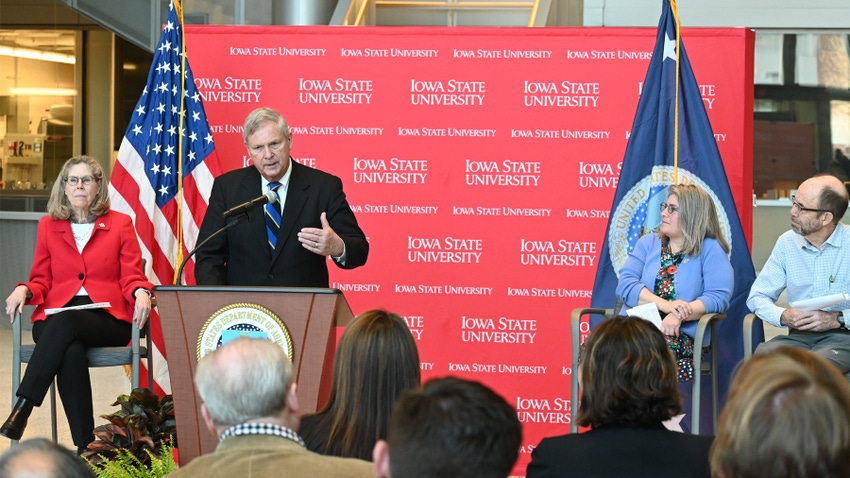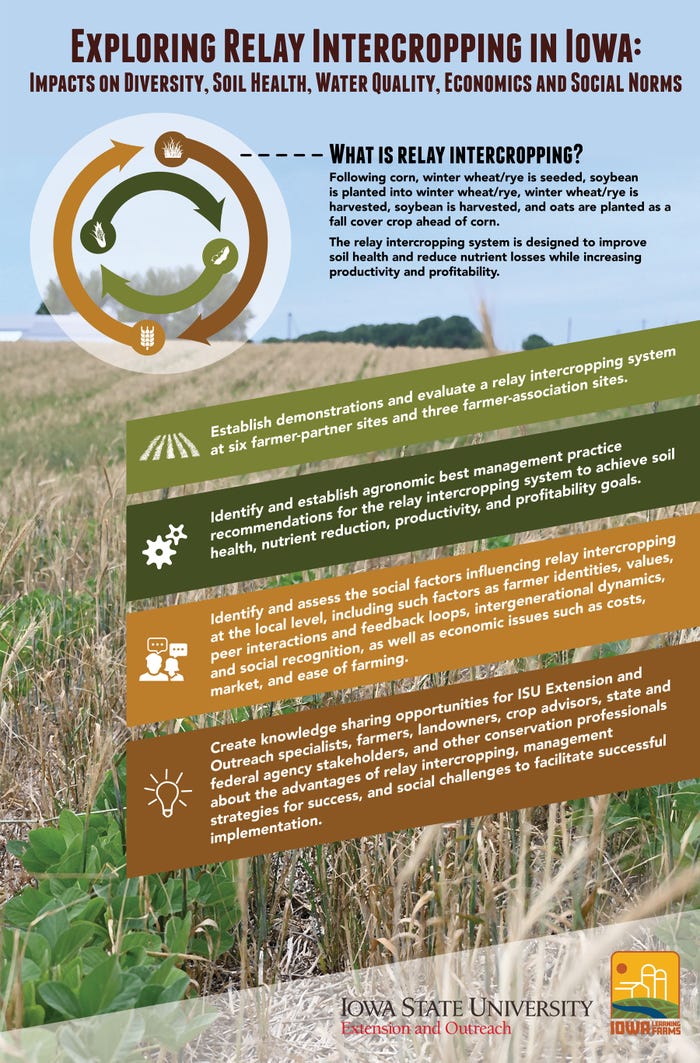April 18, 2023

by Ann Staudt
Among the Conservation Innovation Grants announced by USDA Secretary Tom Vilsack during a visit to Iowa State University in early April was funding for an Iowa Learning Farms (ILF) study of relay intercropping and its impacts on diversity, soil health, water quality, economics and social norms.
Noting the importance of land-grant universities such as ISU in moving science and research forward, Vilsack expressed his support for providing data to enable farming decisions that benefit the greater environment while empowering farmers — particularly those operating small- and medium-sized farms — to participate more fully in the significant positive economic trends that have brought new levels of profitability to the industry.
“We’re empowering our partners to develop new tools, technologies and strategies to support next-generation conservation efforts on working lands and develop cost-effective solutions to resource challenges,” Vilsack said. USDA Natural Resources Conservation Service issued the grants.
Jacqueline Comito, ILF director, was on hand to offer insights into the study goals and structure. The “Exploring Relay Intercropping in Iowa: Impacts on Diversity, Soil Health, Water Quality, Economics and Social Norms” project will involve field-scale implementation of relay intercropping across six commercial farms and three university research farms for three growing seasons.

Relay Intercropping Study Highlights (Infographic by Iowa State University Extension
Relay intercropping in Iowa is a practice in which winter wheat or rye is seeded following corn; soybean is seeded into the winter crop; the wheat or rye is harvested, and the soybean is harvested; and oats are planted as a fall cover crop ahead of corn. The system provides three cash crop opportunities in two years.
“Our project is designed to gather data on the outcomes of a relay intercropping system that integrates cereal grains into corn and soybean production systems,” Comito said. “However, this study looks far beyond the field results. Taking a multifaceted approach, we are looking at economic benefits to farmers as well as soil health and water quality aspects of relay intercropping. In addition, we are investing substantial effort into the social science aspects of implementing a change to the way farming is done in Iowa.”
Learning more about intercropping
Due to limited adoption of this relay intercropping system, data on environmental, agronomic system and economic impacts have not previously been sufficient to inform decision-making for farmers or to determine how it may contribute to nutrient reduction goals. The Iowa Nutrient Reduction Strategy does not currently include this practice in conservation recommendations due to lack of supporting water quality data. This study will help provide the data needed to address both issues.
“We aim to learn what measurable impacts farmers can expect when adopting relay intercropping and use the study outcomes and data to create and share resources for agricultural professionals, landowners and farmers that can help them make informed choices,” Comito said. “However, we are taking a somewhat unprecedented step of conducting a robust ‘boots-on-the-ground’ study of social norms in stakeholder communities, as well as assessing whether implementing this practice is socially accepted by farmers.”
The introduction of an innovative conservation practice such as a third crop is often complicated by farmers’ social identities and the “social loss” a farmer may experience when doing something new. Understanding generational identities and tapping into the values they represent could be one key to adopting new practices such as relay intercropping.
The approach allows the multidisciplinary project team to anticipate the barriers to adoption — not through surveys or interviews, but by looking at it from a “neighborhood” or county perspective interweaving the social dynamics of the community.
A third foundational pillar of this project is a robust outreach and education plan led by the ILF program to provide ongoing exposure to this and other conservation practices. Outreach activities will include field days at the study farms; sharing of best practices and management techniques learned or refined throughout the study; and dissemination of data regarding adoption, adoption reluctance, economic advantages, and water quality and environmental impacts.
“We are grateful to the USDA NRCS for this Conservation Innovation Grant as well as the other organizations that support Iowa Learning Farms and its ongoing research, outreach and education programming that works toward our goal of creating a culture of conservation for all Iowans,” Comito said.
Details of USDA NRCS Conservation Innovation Grants
The grants fall into two categories.
Traditional projects. These projects enable partners to develop new tools, technologies and strategies to support next-generation conservation efforts on working lands and develop market-based solutions to resource challenges.
On-farm projects. These projects support more widespread adoption and evaluation of innovative conservation approaches in partnership with agricultural producers. Incentive payments are provided to producers to offset the risk of implementing innovative approaches.
There are 17 traditional projects funded with $15 million. Fourteen on-farm projects were funded with $25 million. Two of the 14 on-farm projects funded are based at ISU.
See project award details at cig.sc.egov.usda.gov/cig-fiscal-year-2022-awards.
Staudt is a conservation outreach specialist with Iowa Learning Farms and director of Water Rocks.
You May Also Like




